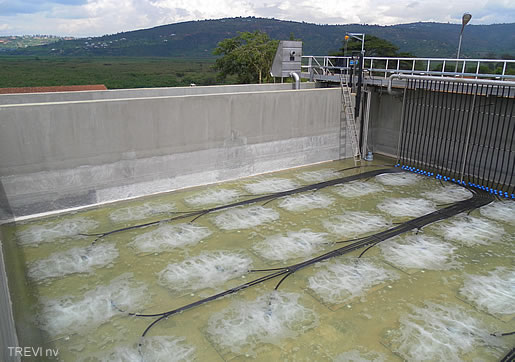Purpose
Nitrogen removal (ammonification, nitrification, denitrification)
Combined with the removal of organic substances (TOC, COD, BOD, ...) and breakdown of biodegradable detergents, oils and fats, ...
Principle
A biological wastewater treatment plant always removes a certain amount of nitrogen from the waste water thanks to the growth of the biomass. When the nitrogen-carbon ratio in a waste water is high, the incorporation of nitrogen in biomass is often not sufficient to respect the discharge limits. By expanding a biological wastewater treatment plant with a nitrification-denitrification process the excess nitrogen is removed biologically.
During this process ammonium nitrogen in the waste water is converted to nitrogen gas in two steps. The first aerated step is the nitrification process. During this process nitrifying bacteria convert ammonia to nitrate. Nitrate is converted to nitrogen gas (N2) in a second non-aerated step. Nitrogen gas is a harmless gas that is abundant in the atmosphere. During this step organic matter is consumed.
Configuration
To upgrade a waste water treatment plant with a nitrification-denitrification process, most of the times an additional non-aerated reactor is added to the waste water treatment plant. This reactor could be installed before (pre-denitrification) or after (post-denitrification) the aeration basin. In a sequencing batch reactor (SBR) the denitrification process is implemented by adding a non-aerated step in the purification process.
Scheme
Applications
Communal waste water and waste water from food process in industries most of the time contain an excess of nitrogen. Also in other industries like the waste processing industry and the pharmaceutical industry this could be the case. When possible pre-denitrification is applied, in that case part of the organic matter in the wastewater is utilized and the need for an external carbon source is omitted.
Example of realisation

Biological WWTP: aeration basin for nitrification
Approach Trevi
Trevi has extensive experience with biological nitrogen removal for both difficult waste waters (toxicity, salinity) and waste waters with high nitrogen concentrations such as the thin fractions of manure and digestate. When opportunities arise Trevi looks to combine complementing waste waters from neighboring businesses to obtain an optimal process. When adding an external carbon source we primarily look at the valorization of carbon rich waste streams as an alternative for expensive chemicals.
.jpg)
.jpg)